Skies are one of the most photographed subjects and make for some really interesting photographs. Shooting skies can seem like an easy job but there are ways to get brilliant and dramatic photographs of skies as well. We will talk in-depth about the different aspects of using the sky as a centre of attraction in your photographs. Sky makes for amazing photographs and makes normal day-to-day pictures pop out. But there are challenges associated with shooting dramatic images including the sky in the frame. Challenges like controlling exposure, being in the right place at the right time etc. Let’s discuss each point in details to have a better understanding of the topic.
Golden hour

Antony Griffiths
It is important to know what a golden hour is, if you wish to become a landscape photographer. Golden hour is the time of the day when the light is perfect for photography. It is usually considered to be the period shortly after sunrise and shortly before sunset. The light at that time is soft and usually has a reddish tone to it which pops the features in a photograph. This light makes for the best cloudscapes. As a photographer, one has to set himself or herself up for the shot sometime before the actual golden hour. During this time the light changes drastically and unpredictably. It is always advisable to be ready to take a shot of the perfect moment.
Include clouds

Alan Chadwick
An empty sky, while beautiful, might not make for the greatest photographs. If the sky is perfectly blue it might compliment a photograph of a monument or cityscape but will not draw as much attention. Including clouds in your otherwise normal shot will make it look much more interesting. Beautiful cloudscapes have become the backbone of landscape photography these days. Clouds provide shapes and textures to photos. It also adds a sense of vastness to the photograph.
Use a wide angle lens

Using a wide lens sounds to be pretty straight forward. But it is important to know when and where to use a wide lens. A wide lens adds a sense of depth to the photographs. Cloudscapes look amazing when shot with wide lenses. During the golden hours it also allows one to show more lights and colours as it captures a greater angle of view. Using a wide lens when shooting monuments etc with cloudscapes is not advisable as a monument might look distorted in extreme wide angles. If you are not sure of what lens would be appropriate try both and see which one feels right. More often than not, the wide lens will look more visually interesting.
Be patient

Patience is a key attribute to photographing cloudscapes. While some might think that photography is all about the camera and how the user uses it, for this particular genre patience is the key to having the most dramatic photos. Since clouds are unpredictable and nature changes every second it is highly likely that a photographer might have to wait a long time for the perfect shot. If you do not want to wait for too long then try visiting the places during the golden hour. It is almost always the best time to get cloudscapes. Choosing your shooting spot beforehand is a must since you can plan your shoot accordingly. It is important to remember that sometimes even the utmost patience will not yield expected results but that should not get a photographer disheartened. The hunger for good photographs should drive one’s passion.
Include other elements

Clouds make for amazing photographs but shooting just clouds is not enough. Silhouettes of people, monuments, bridges or even a mountain range or any other object looks good with cloudscapes. Clouds alone do not make good pictures since there is no single point of attraction. Shooting just clouds is like shooting patterns. You need to break a pattern to provide for the eye of a viewer to wander and fix itself on a single object in the frame. Including other elements makes photographs more interesting and breaks the monotony.
Control exposure

One of the most difficult things to do while shooting dramatic cloudscapes is controlling the exposure. There are a few workarounds to the challenges. Using ND filters, Polarizing filters are a good way to bring down the exposure of the sky if you do not want your foreground to be silhouetted. If the subject (foreground) is close to the camera using a flash can create beautiful photographs as well. But make sure that the flash is not too harsh as the foreground will be completely spoilt otherwise. Make sure that while shooting cloudscapes, you do not aim your camera directly at the sun. Sometimes underexposing a little might dramatise the sky.

